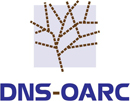DNS-OARC
 | |
| Type: | non-profit organization |
| Industry: | Internet, DNS security |
| Headquarters: | 950 Charter Street, Redwood City, CA 94063, U.S.A. |
| Website: | dns-oarc.net |
| LinkedIn: | DNS-OARC |
| Key People | |
| Matt Larson, Chairman of the Board Suzanne Woolf, President, Treasurer, Secretary Ondrej Filip, At-Large Director Stephane Bortzmeyer, At-Large Director Peter Koch, At-Large Director Matt Pounsett, At-Large Director | |
The DNS-OARC, or Domain Name System Operations Analysis and Research Center (also known as OARC) plays a significant role in bringing together important DNS implementers, operators and researchers on a single platform to ensure that there is a proper coordination of responses to various concerns and attacks related to the DNS. It also adds a major fillip in the sharing of information and learning together among the various operators and implementers.[1]
The Mission of DNS-OARC
The DNS-OARC is a not-for-profit organization that works towards enhancing the security and stability of the DNS, as well as improving understanding of the DNS infrastructure. The main mission of the OARC is to build good relationships between its members and to create an environment to ensure that there is a secure flow of information between its members. It also works towards increasing awareness about the importance of the DNS and provides all the necessary DNS tools and services to the public.[2]
Participants of the OARC
The participants of the OARC are divided into several categories:
- Implementers: These participants in the OARC produce all types of DNS technology such as appliances, software and all types of other network elements, which also include load balancing hardware.
- Operators: These participants of the OARC include the root, TLD, and large commercial nameservers who make use of DNS technology and produce all types of DNS services.
- Security Providers: These participants of the OARC are the companies who offer products and services that make use of DNS information to enhance the security of their consumers.
- Researchers: These mostly includes participants who have a strong DNS emphasis and who are in need of accessing as well as tracing the long data related to the global DNS under both normal and abnormal conditions.[3]
The functions of the OARC
The OARC carries out the following important functions:
- Conducting workshops: The OARC conducts semi-annual workshops wherein the public as well as its members participate and give presentations on all the latest topics related to the DNS. These presentations are mostly concerned with research and operations of the DNS.
- Information sharing: The DNS-OARC is known to provide a platform for the DNS operations community to share information and data. The DNS-OARC has implemented some strict confidentiality requirements and also works towards providing a secured means of communication while ensuring that there is two-way sharing of information.
- Operational characterization: Owing to the increasing traffic levels and the extensive demand of the infrastructure, the OARC works towards measuring the performance and the load of all important nameservers.
- Tools and services: The DNS-OARC also develops tools and services and makes them available for public use so that problems related to the DNS are properly detected, highlighted, and solved on a timely basis.
- Analysis: The leading developers and researchers in OARC provide a consistent and long-term analysis of DNS performance as well as conduct an autopsy of DNS attacks for the sake of institutional learning. It also provides a well-provisioned system for its members to download logs and traces so that they can conduct independent analyses.[4]
OARC and ICANN
The Internet Corporation for Assigned Names and Numbers (ICANN) is a gold member of the OARC.[5] DNS-OARC has previously commented on ICANN’s DNS-CERT. OARC recommended a constituency for the CERT. It was also of the view that the CERT will have to gain support from the outside constituencies as well as from the other CERTs to ensure reduction of threats and to share incidents.[6]
References
